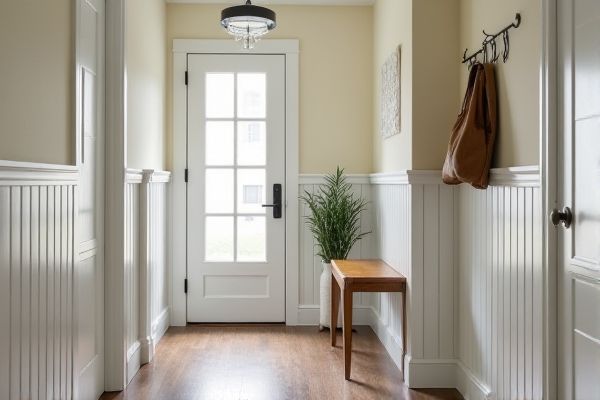
Mudroom paneling offers durable, easy-to-clean protection against dirt and moisture, ideal for high-traffic entryways, while wainscoting adds a decorative, classic touch with partial wall coverage usually made from wood or MDF. Explore this article to discover which option best suits your style and functional needs for your mudroom.
Table of Comparison
| Feature | Mudroom Paneling | Wainscoting |
|---|---|---|
| Purpose | Durable protection for high-traffic mudrooms | Decorative lower wall treatment in formal spaces |
| Material | Water-resistant wood, PVC, or composite panels | Wood, MDF, or vinyl panels with decorative molding |
| Installation Height | Floor to about 4-5 feet | Typically 32-42 inches from floor |
| Functionality | Protects walls from dirt, moisture, and impact | Enhances wall aesthetics and adds architectural detail |
| Style | Practical, rustic, or modern designs | Traditional, formal, or classic styles |
| Maintenance | Easy to clean, often washable surfaces | Requires occasional repainting or touch-ups |
| Cost | Moderate to high depending on materials | Varies with design complexity; generally moderate |
Introduction to Mudroom Paneling and Wainscoting
Mudroom paneling offers a durable and moisture-resistant wall treatment designed to withstand heavy use and protect walls from dirt and wear, making it ideal for entryways and utility spaces. Wainscoting, traditionally a decorative wood paneling applied to the lower portion of walls, enhances aesthetic appeal while providing moderate protection against scuffs and damage. Both mudroom paneling and wainscoting vary in materials, styles, and installation methods, catering to different functional and design needs in transitional spaces.
Defining Mudroom Paneling: Features and Uses
Mudroom paneling typically features durable, moisture-resistant materials designed to withstand heavy traffic and outdoor elements, making it ideal for mudroom environments where shoes, coats, and bags are frequently stored. It often includes beadboard or shiplap styles that provide both protection and aesthetic appeal, enhancing the functionality and organization of your entryway. Unlike wainscoting, which emphasizes decorative lower wall treatment, mudroom paneling prioritizes resilience and ease of cleaning, perfectly suited for managing dirt and wet conditions.
Understanding Wainscoting: Styles and Functions
Wainscoting enhances your mudroom by providing decorative and protective wall paneling available in various styles such as raised, flat, beadboard, and board-and-batten, each offering unique textures and visual appeal. This architectural feature not only adds style but also safeguards lower walls from moisture, dirt, and wear, making it ideal for high-traffic areas like mudrooms. Choosing the right wainscoting style balances aesthetics with durability, ensuring your mudroom paneling meets both functional and design needs.
Key Design Differences: Paneling vs. Wainscoting
Mudroom paneling typically features full-height or partial wall coverage with smooth or textured boards, creating a continuous protective and decorative surface, while wainscoting is a specific type of wall treatment characterized by wood panels covering only the lower portion of a wall, often topped with a chair rail molding. Paneling offers a more versatile and modern aesthetic, providing durability against mudroom wear and tear, whereas wainscoting adds classic architectural detail and visual interest through raised or recessed panel designs. Your choice depends on whether you prioritize full wall protection and contemporary style or a traditional, elegant accent that enhances the room's character.
Material Options for Each Wall Treatment
Mudroom paneling offers versatile material options such as durable vinyl, water-resistant beadboard, and sturdy wood planks designed to withstand moisture and heavy wear. Wainscoting commonly features traditional hardwoods like oak, cherry, or MDF with paint-grade surfaces, emphasizing aesthetic appeal over moisture resistance. Choosing the right material for your mudroom depends on balancing durability and style, ensuring your wall treatment meets both functional and design needs.
Durability and Maintenance Comparison
Mudroom paneling offers superior durability due to its thicker boards and moisture-resistant finishes, making it ideal for high-traffic, wet environments. Wainscoting, often made from thinner wood panels with decorative molding, requires more frequent maintenance to prevent damage from water and heavy use. To keep your mudroom looking pristine, choosing paneling reduces upkeep and withstands daily wear better than traditional wainscoting.
Mudroom Aesthetic: Which Option Fits Your Space?
Mudroom paneling offers a practical and durable surface ideal for handling moisture and dirt, making it perfect for high-traffic entryways. Wainscoting enhances aesthetic appeal with decorative details and traditionally covers the lower portion of walls, adding elegance without overwhelming the space. Choosing between mudroom paneling and wainscoting depends on balancing functionality with style to best complement your mudroom's size, usage, and design preferences.
Installation Process and Cost Considerations
Mudroom paneling typically involves large, durable panels or beadboard that are easier and quicker to install, reducing labor costs and overall expenses compared to wainscoting. Wainscoting requires precise measurement, cutting, and fitting of individual trim pieces or raised panels, increasing both installation time and labor costs. Material prices for mudroom paneling are generally lower, making it a budget-friendly option for high-moisture areas, while wainscoting offers a more decorative finish at a higher price point.
Pros and Cons: Mudroom Paneling vs. Wainscoting
Mudroom paneling offers durable protection against moisture and dirt, making it ideal for high-traffic entryways, while its seamless design simplifies cleaning. Wainscoting enhances aesthetic appeal with decorative patterns and adds a layer of wall protection but may be less resistant to heavy wear and requires more maintenance. Choosing between mudroom paneling and wainscoting depends on balancing practicality with style preferences and the level of durability needed for the space.
Making the Right Choice for Your Home
Choosing between mudroom paneling and wainscoting hinges on durability and aesthetic preferences for your home's entryway. Mudroom paneling offers robust protection against moisture and dirt, ideal for high-traffic areas, while wainscoting provides a classic, decorative touch with partial wall coverage. Assessing factors like maintenance, moisture resistance, and design style ensures the right functional and visual impact for your home's unique environment.
 homyna.com
homyna.com